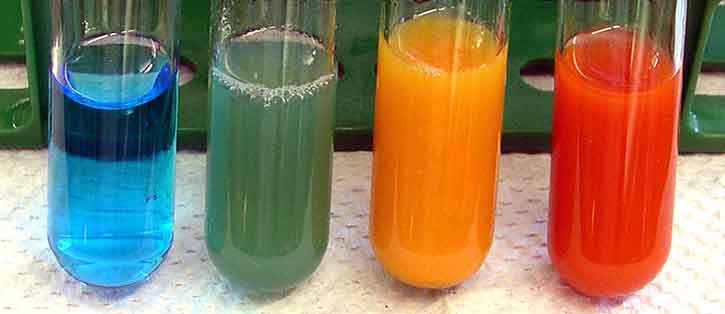|
|
Organic Molecules
These are complex, carbon-containing molecules associated with living organisms. Most also contain hydrogen and oxygen. There are five major types: carbohydrates, lipids, proteins, nucleic acids, and vitamins. We covered the first three types in lab. A review of our carbohydrate test data is provided on this page. Click the molecule types above to link to the associated review material. |
|
Benedict's Reagent: A Test for Reducing Sugars
Carbohydrates are divided into two groups based on the complexity of their structure. Simple carbohydrates can form either a single ring structure (monosaccharides) or a double ring structure (disaccharides -- formed when a pair of monosaccharides bond). Simple carbohydrates include familiar sugars such the monosaccharides glucose (the basic fuel of cells) and fructose (found in fruits). Common disaccharides include sucrose (table sugar) and lactose (the sugar in milk).
Complex carbohydrates (polysaccharides) are chains of many bonded simple carbohydrates, and are often used for energy storage. These include starch, cellulose, and glycogen.
One test for the presence of many simple carbohydrates is to use Benedict's reagent. It turns from turquoise to yellow or orange when it reacts with reducing sugars. These are simple carbohydrates with unbound aldehyde or ketone groups. In lab, we used Benedict's reagent to test for one particular reducing sugar: glucose.
|
Interpreting Benedict's Reagent Results
Benedict's reagent starts out aqua-blue. As it is heated in the presence of reducing sugars, it turns yellow to orange. The "hotter" the final color of the reagent, the higher the concentration of reducing sugar. In general, blue to blue-green or yellow-green is negative, yellowish to bright yellow is a moderate positive, and bright orange is a very strong positive. (See below). |
1: Benedict's Reagent
& Water
(Negative control).
|
2: Benedict's Reagent & Unknown: Negative rx
(No reducing sugars). |
3: Benedict's Reagent & Unknown: Positive rx
(Some reducing sugars). |
4: Benedict's Reagent & Glucose Solution
(Positive control).
|
 |
Terminology review: Controls
Water plus Benedict's reagent is a negative control for the sugar test. It demonstrates a negative test result (no sugar present). See tube 1 above.
Glucose plus Benedict's reagent is a positive control for the sugar test. It demonstrates what a strong positive result should look like. It also proves that our reagents haven't gone bad (they are capable of producing a positive result). See tube 4 above.
The point of controls is twofold. They give you standards to compare against, and they demonstrate that your reagents are working correctly. |
|
Class Benedict's Reagent Results
Aside from our controls, we tested three solutions for glucose: starch, acid-treated starch, and amylase-treated starch. As starch is a polysaccharide, it is unsurprising that the starch solution tested negative for simple sugars.
We mixed HCl (an acid) into starch and re-tested for simple sugars. First, we had to adjust the pH of the solutions back to neutral before adding the Benedict's reagent. We used a pH indicator and NaOH (a base) for this. We then added the Benedict's reagent. We got moderately positive results (orangish color). This is because HCl breaks starch back down into its component monosaccharides (glucose, in this case).
Amylase is an enzyme that removes glucose molecules from starch. Both plants and animals use amylase when digesting starch. Unfortunately, amylase cannot break the beta-bonds which hold the glucose molecules together in cellulose. (If it could, we'd be able to eat hay). Based on this information, can you figure out what our results should be if we tested amylase-treated starch and amylase-treated cellulose solutions for reducing sugars?
|
|
|
|